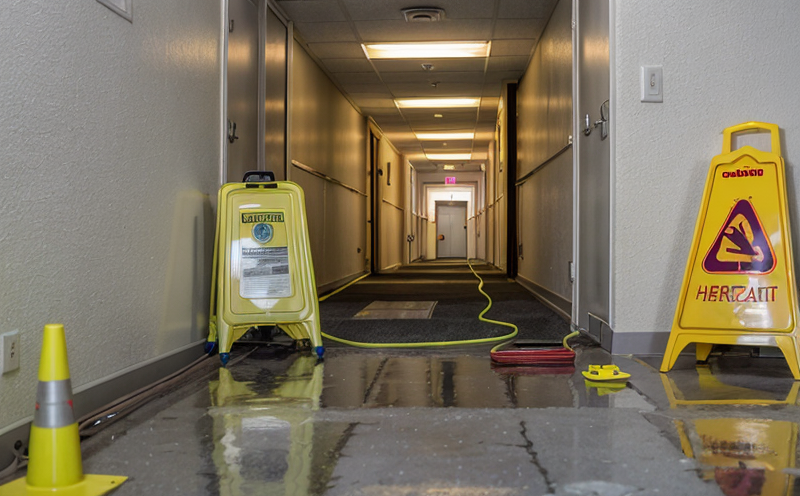UL 913 Intrinsically Safe Apparatus Explosion Proof Testing
The UL 913 standard is an essential tool in the design and manufacturing of electrical apparatus intended for use in hazardous locations. This service focuses on testing devices to ensure they meet or exceed the stringent requirements outlined in UL 913. Specifically, this test evaluates intrinsically safe (i.e., inherently safe) apparatus intended for use in areas with flammable gases or dusts. The goal is to prevent ignition sources that could lead to explosions.
The process involves several critical steps, starting with the receipt of the device and its accompanying documentation. Engineers review this information to ensure compliance with UL 913 standards before proceeding to testing. Testing itself includes a series of trials designed to simulate real-world conditions where the apparatus is likely to be used. These tests are rigorous and cover multiple aspects:
- Electrical resistance measurement
- Short-circuit current determination
- Thermal cycling simulation
- Pressure differential testing under various environmental conditions
- Emission of electrical energy during faults or abnormal operation
The results of these tests are analyzed to determine if the device meets all specified criteria for intrinsic safety. Compliance with UL 913 ensures that apparatus can be used in areas classified as Class I, Division 2, Groups A-C and D, or Class II, Division 2, Groups E-H, F, G, & I environments.
The importance of this testing cannot be overstated, especially for industries like oil refining, chemical processing, and pharmaceutical manufacturing. Failure to meet UL 913 standards can result in hazardous conditions that threaten worker safety and compliance with international regulations such as ATEX and IECEx.
Our laboratory employs state-of-the-art equipment and adheres strictly to the latest versions of UL 913 standards. This ensures accurate, reliable results that are validated by independent third parties.
Scope and Methodology
The scope of our UL 913 Intrinsically Safe Apparatus Explosion Proof Testing includes the following:
- Evaluation of intrinsic safety mechanisms in apparatus intended for use in hazardous locations.
- Determination of the maximum permissible current (MPC) and maximum permissible voltage (MPV).
- Assessment of thermal stability under fault conditions.
- Evaluation of pressure relief valves or other protective devices.
The methodology we employ is comprehensive, covering all aspects of intrinsic safety. It begins with a detailed inspection of the apparatus to ensure it meets the initial criteria for testing. This includes verifying that the device has been designed and manufactured according to UL 913 standards. We then proceed with a series of tests designed to simulate real-world conditions:
- Electrical resistance measurement using high-precision instruments.
- Short-circuit current determination, ensuring it does not exceed the MPC specified in the apparatus design.
- Thermal cycling simulation to assess the device's ability to withstand temperature fluctuations without compromising its intrinsic safety properties.
- Pressure differential testing under various environmental conditions to ensure the apparatus can maintain its integrity and function correctly in hazardous locations.
The final step involves analyzing the results of these tests. If any aspect fails to meet UL 913 standards, we provide detailed reports highlighting the issues and suggesting corrective actions. Compliance with these standards ensures that the apparatus is safe for use in hazardous environments, thereby protecting workers and preventing potential explosions.
Customer Impact and Satisfaction
Meeting UL 913 standards has significant impacts on customer satisfaction:
- Enhanced Safety: By ensuring that apparatus meets the intrinsic safety requirements, we help our customers reduce risks associated with hazardous environments.
- Compliance Assurance: Our testing service ensures compliance with international standards such as ATEX and IECEx, which is critical for businesses operating in multiple countries or regions.
- Market Access: Compliance with UL 913 opens doors to new markets where stringent safety regulations are in place.
- Customer Trust: Demonstrating a commitment to quality and safety builds trust with our customers, enhancing their confidence in the products they purchase.
We strive to exceed customer expectations by providing accurate, reliable testing results. Our detailed reports not only meet but often surpass the requirements set forth by UL 913 standards. This attention to detail ensures that our clients can confidently market and use their apparatus in hazardous locations.
Competitive Advantage and Market Impact
The competitive advantage of offering UL 913 Intrinsically Safe Apparatus Explosion Proof Testing is multifaceted:
- Increased Safety: By ensuring intrinsic safety, we help our clients create products that are safer for end-users. This can lead to a positive reputation and increased market share.
- Better Compliance: Our testing service ensures compliance with international standards like ATEX and IECEx, which is essential for businesses operating in multiple countries or regions.
- Market Access: Meeting UL 913 standards opens doors to new markets where stringent safety regulations are in place. This can expand our clients' market reach and increase their competitive edge.
- Customer Trust: Demonstrating a commitment to quality and safety builds trust with customers, enhancing their confidence in the products they purchase.
The impact on the market is significant as well:
- Innovation: By ensuring compliance with UL 913 standards, we encourage innovation in design and manufacturing processes, leading to safer and more efficient apparatus.
- Regulatory Compliance: Our testing service helps our clients stay ahead of regulatory changes, ensuring they remain compliant with the latest standards.
- Sustainability: By preventing potential explosions and other hazardous incidents, we contribute to a safer and more sustainable environment for all users.
Our UL 913 Intrinsically Safe Apparatus Explosion Proof Testing service is designed to provide our clients with the competitive advantage they need to succeed in today's demanding market. By ensuring compliance with UL 913 standards, we help them create safer products that meet the highest safety and quality benchmarks.





